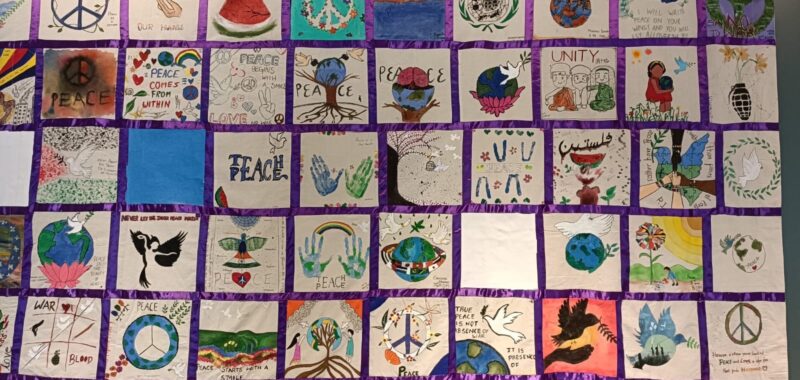United Nations (UN) exhibition staff removed part of a public art exhibition in its General Assembly Lobby in New York City after Israel’s Permanent Representative to the UN Danny Danon condemned references to Palestine contained in some of the works.
The exhibition, titled The Global Peace Flag: Uniting the World and on view through November 15, features collaborative quilts made of repurposed fabric scraps decorated with messages by individuals from 195 countries with painted expressions of “hope for a peaceful future,” Runa Ray, the environmentalist fashion designer who organized the show, told Hyperallergic. “People are invited to express their visions of an equitable world on these canvases,” the wall text reads. The exhibition is endorsed by the UN’s Sustainable Development Goals Action Campaign, and many of the participants, according to Ray, were young people including children.
The portion removed by the UN was a quilt with Palestinian liberation references. One panel read “from the river to the sea” next to a watermelon drawn in the shape of the map of historical Palestine and the words “will be free.” (In an address to the UN General Assembly in September, Israeli Prime Minister Benjamin Netanyahu displayed a similar map showing all of the territory as part of Israel, including the Occupied West Bank and the Gaza Strip.) Another removed section of the quilt read “Free Palestine” written over a Palestinian flag.
In a November 4 video posted on X, Danon said the messages promoted “hate” and called for the UN to immediately remove the entire installation “and stop with the hypocrisy against Israel.” Most other quilts on view do not reference Israel or Palestine.

Reached for comment by Hyperallergic, Danon wrote, “We wish the exhibition just promoted peace, but as I exposed earlier this week, the UN had installed some art that had openly and unequivocally called for the destruction of the State of Israel. That is unacceptable. After I highlighted this deeply disturbing art, the UN took down that part of the exhibition.”
UN’s exhibition staff flagged “controversial” language when the installation was mounted three weeks ago, and asked Ray to cover the panel with the explicit Palestine references in tape, Acting Chief of UN Visitors Services Vincenzo Pugliese told Hyperallergic. In a photo of the now-removed quilt provided by Ray, two panels appear covered in a blue-and-white material. Last week, Pugliese said, someone removed the tape from the covered panel on two separate occasions, after which staff made the call to replace the quilt entirely.
Ray, in a statement to Hyperallergic, said that the project “condemns all forms of terrorism, genocide, and violence unequivocally.”
“I wish to clarify that the project does not seek to critique or politicize any nation or issue; rather, it exists to foster unity and understanding through art,” Ray said.
Ray said she “deeply” respected Israel’s concerns, and that in the future, she aspires “to place flags from all nations — including those that have historically experienced conflict — side by side. This arrangement is not intended to ignore or minimize differences but to showcase the universal desire of people to live in harmony.”

Other displayed quilts include Egyptian, Tibetan, Ukrainian, and Puerto Rican flags, while some squares call for more generic action to combat violence against women, put an end to plastic manufacturing, and stop war.
On Tuesday morning, November 5, the large quilt featuring Palestine references including a watermelon slice with the caption “No War!” was replaced with another quilt that was previously not displayed due to a lack of wall space, Pugliese said. Ray told Hyperallergic that the panels on the now concealed quilt came from multiple countries, but not from Palestine or Israel.
Last month, the UN accused Israel of war crimes in Gaza over the destruction of health infrastructure. Israel’s parliament also passed legislation banning the United Nations Relief and Works Agency (UNRWA), which had been providing humanitarian aid to Palestinian refugees for 80 years, from operating within the country.
In response to an inquiry about whether the UN found that the works promoted “hate,” as expressed by Danon, Pugliese wrote, “The UN was founded to encourage peaceful relations and collaboration among its Member States through maintaining peace and security, furthering the Sustainable Development Goals (SDGs), and promoting the respect and protection of human rights.”
Ray added that the Global Peace Flag project unequivocally supports “peace, equality, and respect for all.”
“The project’s core mission is to create a platform where people’s desire for peace can be heard, independent of the political agendas,” Ray said.
Hyperallergic has called and emailed the office of the Palestinian Ambassador to the United Nations in New York City for comment.

While the expression “from the river to the sea” has been interpreted by some as a call for the obliteration of Israel, scholars have long defended the phrase as a statement for freedom and equality for Palestinians.
Since October 2023, multiple art exhibitions have been altered or taken down completely in the United States and internationally for pro-Palestine mentions, including the “from the river to the sea” slogan. In May, Oolite Arts in Miami removed a window installation by artist Khánh Nguyên Hoàng Vũ over its inclusion of the phrase, prompting the artist to release an open letter signed by over 300 Florida artists. Outside Toronto last month, a cultural center shuttered an exhibition curated by the granddaughter of a Holocaust survivor after some residents complained that works bearing the words “Intifada” and “Free Palestine” were antisemitic.
In late October, the Brooklyn nonprofit UrbanGlass apologized for excluding an artwork by Palestinian-American artist Phil Garip from an exhibition in March. The organization acknowledged in a statement that its removal of the work, which bore the phrase “from the river to the sea” in neon, “not only silenced an artistic expression but also contributed to the widespread marginalization of Palestinian artists.”


